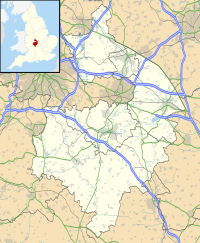Fillongley Castle
| Fillongley Castle | |
|---|---|
| Fillongley, England | |
| Coordinates | 52°28′42″N 1°35′22″W / 52.47843°N 1.58945°W |
| Grid reference | grid reference SP00109848 |
| Type | Motte and bailey castle, then a fortified manor house |
| Site information | |
| Open to the public | Yes |
| Condition | Ruined |
| Site history | |
| Built |
|
| In use |
|
| Materials | Timber and later stone masonry |
Fillongley Castle was a motte and bailey castle and later a fortified manor house in Fillongley in Warwickshire, England. Today, only earthworks and partial ruins exist.[1]
The Castle Yard site has been a scheduled ancient monument since 1951.[2] The Castle Hill or Hills site has been a scheduled ancient monument since 1925.[3]
History
[edit]Castle Hills
[edit]The first castle at Fillongley, formerly known as Fillungeleye Castle, was located at Castle Hills and was constructed from timber with a moat around 1135 and was abandoned by the 13th century, probably before 1272.[4] It was known as Old Fillongley during the reign of Henry III (1216-1272).[1]
Castle Yard
[edit]The second castle, located in Castle Yard, was probably a fortified manor house (also with a moat), held by the de Hastings family and built around the same time, c. 1135.[1]
In February 1300/1 his son John Hastings (1262–1313), Baron Bergavenny, had licence to crenellate his "manor and town of Fillongley in Warwickshire".[5] He was buried at the Greyfriars in Coventry. The manor house was still standing during the reign of Edward III (1327–1377), but was unoccupied by the de Hastings. In 1389, it passed to the Beauchamp family holding the Earl of Warwick title and was repurposed into a manor house during the 14th century before being abandoned during the 15th century,[6] with stone from the castle being used to repair buildings within the village of Fillongley.[6]
Most of the surviving ruins of Fillongley Castle have remained unchanged since at least the 19th century and have been owned by Bonds Hospital Charity since 1980.[7] The site of the castle had become overgrown by c. 2012, so the ruins were sprayed with Murcam, which also led to partial habitat destruction and loss of biodiversity.[7]
References
[edit]- George Thomas Clark. Mediæval Military Architecture in England. Wyman & Sons. 1884. vol 2. pp 47, 48 & plate.
- "Fillongley" (1883) 44 The Builder 241 and 244 (24 February 1883)
- Willoughby Gardiner. "Fillongley" in "Ancient Defensive Earthworks". Doubleday and Page (eds). The Victoria History of the County of Warwick. Archibald Constable and Company. James Street, Haymarket, London. 1904. vol 1. pp 375 & 376.
- James Dixon Mackenzie. "Fillongley". The Castles of England: Their Story and Structure. The Macmillan Co. 1896. vol 1. pp 348 & 349.
- Frederick Wilkinson. "Fillongley Castle". The Castles of England. George Philip. 1973. p 80.
- Phillip B Chatwin "Fillongley, Castle Hills" and "Fillongley, Castle Yard" in "Castles in Warwickshire" (1947 to 1948) 67 Birmingham Archaeological Society: Transactions and Proceedings 22 to 23 and 25 to 26.
- Mike Salter. The Castles and Moated Mansions of Warwickshire. Folly Publications. 1992. p 28.
- J Tom Burgess, "Early Earthworks in Warwickshire" [1872] Birmingham and Midland Institute: Archaeological Section: Transactions, Excursions and Reports 88 & plate vii
- (1965) 80 Birmingham Archaeological Society: Transactions and Proceedings 32
- Michael Aston. Medieval Fish, Fisheries and Fishponds in England. BAR British Series 182(i) and (ii). BAR. 1988. p 426.
- Adrian Pettifer. English Castles: A Guide by Counties. The Boydell Press. 1995. p 263.
- Anthony Emery. Greater Medieval Houses of England and Wales, 1300-1500. Cambridge University Press. 2000. vol 2. p 88.
- Lynne R Williams. "Castles in the Air". The Little Book of Warwickshire. 2015.
- Transcript of the Old Parish Register of . . . Fillongley . . . 1538-1653. W Henry Robinson. 1893. pp xi & xii.
- Mary Dormer Harris. "Fillongley and the Castle of the Hastingses". Unknown Warwickshire. 1925. Chapter 24. p 174 at pp 175 to 177. Google
- J E B Gover, A Mawer and F M Stenton. "Castle Hill and Yard". The Place Names of Warwickshire. Cambridge University Press. 1936. p 83. Google
- Lyndon F Cave. Warwickshire Villages. Robert Hale. 1976. p 163. Google
- Arnold Fellows. England and Wales: A Traveller's Companion. 2nd Ed. Clarendon Press. 1964. p 345.
- F R Banks. Warwickshire and the Shakespeare Country. (Penguin Guides). 1960. p 123. Google
- The Geology of the Country around Coventry. HMSO. 1923. pp 83 & 84. Google
- ^ a b c King, D.J.C., (1983), Castellarium Anglicanum (London: Kraus) Vol. 2 p. 482
- ^ Historic England. "Ringwork Castle 80m South West of Castle Farm, Fillongley (1013152)". National Heritage List for England. Retrieved 4 July 2023.
- ^ Historic England. "Castle Hills: a Motte and Bailey Castle 700m NE of St Mary and All Saint's Church (1011367)". National Heritage List for England. Retrieved 4 July 2023.
- ^ King, D.J.C. and Alcock, L., (1969), 'Ringworks in England and Wales' Château Gaillard Vol. 3 p. 90-127
- ^ G. E. Cokayne, The Complete Peerage, n.s., vol. VI, p. 347
- ^ a b Salzman, L.F. (ed), (1947), 'Parishes: Fillongley' VCH Warwickshire Vol. 4 p. 69-71
- ^ a b "Fillongley History". Fillongley History. Retrieved 26 May 2023.

